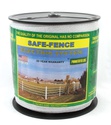Resources
Safe Fence -Installation
Number of Strands: Determining the right number of strands to use and the height of your fence requires some evaluation. The type of horses and the amount of property is first. If you ride as a casual pastime and have trail type, mature horses, 3 strands will be sufficient for pasture areas. Rule of thumb: less than 1 acre per horse use 4 strands, more than 1 acre per horse 3 strands is sufficient. If you have breeding stock with foals 4 strands is a must. Stallions, depending on their attitudes may require 5 or 6 strands, 5 to 6 feet tall. The average height of most installations is 54 inches to the top of the posts and 50 inches to the top strand. Spacing between strands would be 13 inches with 3 strands, leaving 24 inches from ground to bottom strand. On 4 strand installations, at 54 inches post height, spacing between strands would be 10 inches, leaving 20 from the ground to the bottom strand. If you are using 5 foot long Safe-Tee-Sleeves over tee-posts you may go the full 5 feet or cut of the bottoms to the height you desire. However you should never exceed 15 inch spacing between strands. Boarding facilities should always put up 4 strands at 5 feet high due to the prospect of new animals that may be unfamiliar with electric fence. It also adds aesthetic value and a very secure appearance that your customers will value. Pasture separations and in cell grazing applications 2 strands may be used were no foals are present. Never use less than 3 strands for perimeter fencing or less than 4 strands where property parallels a highway.
Soil: Soil condition is an issue that must be considered when installing electric fencing. Dry or sandy soil may require a fence charger with greater power than in moist areas where green foliage is abundant year around. See Improving Your Ground System for more information on reliable electric fence operation in arid conditions.
Expansion: When choosing the fence charger it is recommended to not only consider the area being fenced, but to look ahead at fence to be added later. That way the right charger may be purchased the first time around.
Gates: Location of gates, type, and amount of traffic going through the area is an important consideration. Installing metal gates in high traffic areas and in corners makes handling animals easier. Electric gates are great for pasture separations or implement traffic.










